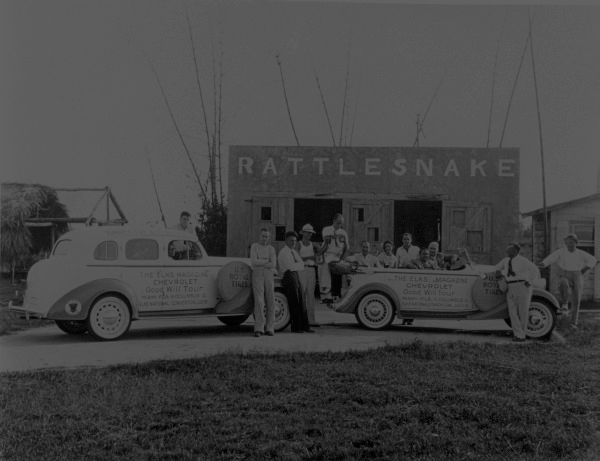During the late 1930s, the Inter-bay peninsula of Tampa was so ridden with the Eastern Diamondback Rattlesnake that a portion of the town came to be known as Rattlesnake, Florida. The area near Gandy Boulevard and Westshore in Old Tampa Bay was almost entirely comprised of pine and palmetto thickets, making it the perfect breeding ground for the once common Eastern Diamondback Rattlesnake — the most poisonous snake in the country. Some of these snakes measured up to be six and half feet in length, and numbered in the thousands.
In 1937, Wisconsin-native George End moved to Florida to farm. He soon discovered he could not earn a living from the poor conditions of his vegetables, especially since his farm was often over-run by rattlesnakes. Curious about what rattlesnake meat tastes like, George decided to fry some up for his family one day. Tasting of chicken with a hint of quail, the rattlesnake meat was a hit. After a successful test-feeding at a veterans gathering, George went on to open a canning plant for rattlesnake meat. The operation’s best-selling item, “SnakeSnaks,” were thin slices of smoked and salted rattlesnake meat. By 1940, George End’s Floridian Products Co. was shipping out approximately 15,000 cans annually. Rattlesnake quickly became a delicacy served in swanky restaurants in large cities such as New York and Los Angeles.
According to Florida Memory — State Library and Archives of Florida, “As the shadow of World War II emerged on the horizon at the start of the 1940s, George End was threatened with the loss of his most vital helpers in the rattlesnake industry, the young men of soldiering age who went out and caught the snakes.” End confidently claimed that despite these troubles, Rattlesnake, Florida would “go on to bigger and better things, in spite of hell, Hitler and high water.”
In the Summer of 1944, End was working with a six-foot rattlesnake that had just arrived at his headquarters when the snake struck his right hand. For all the time George had spent working with deadly rattlesnakes, he had never been bitten before, but once was enough. He administered antivenom to himself, but it was ineffective. He died in a matter of hours.
Following his passing, George End’s wife closed down the plant and sold the cannery equipment along with its patents and formulas to herpetologist Ross Allen, whose Reptile Institute served as both a tourist attraction and a site for antivenom research.
The history of George End and his rattlesnake industry is one of many peculiar attractions that are considered treasures of the Sunshine State’s humble past.



